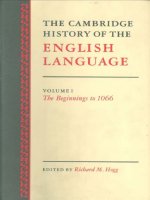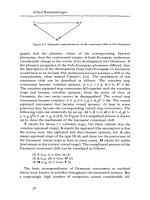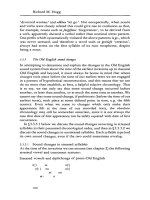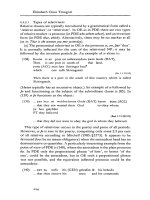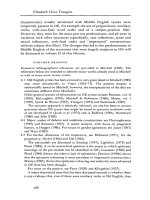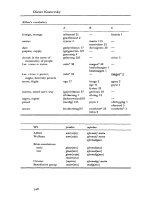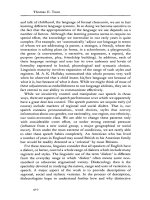The cambridge history of china volume 3 sui and tang china, 589 906, part i
Bạn đang xem bản rút gọn của tài liệu. Xem và tải ngay bản đầy đủ của tài liệu tại đây (18.87 MB, 809 trang )
THE CAMBRIDGE HISTORY
OF CHINA
General editors
D E N I S T W I T C H E T T and J O H N K. FAIRBANK
Volume 3
Sui and T'ang China, 589-906, Part 1
Cambridge Histories Online © Cambridge University Press, 2008
Tai Lieu Chat Luong
Cambridge Histories Online © Cambridge University Press, 2008
THE CAMBRIDGE
HISTORY OF
CHINA
Volume 3
Sui and T'ang China, 589-906, Part I
edited by
DENIS TWITCHETT
CAMBRIDGE
UNIVERSITY PRESS
Cambridge Histories Online © Cambridge University Press, 2008
CAMBRIDGE UNIVERSITY PRESS
Cambridge, New York, Melbourne, Madrid, Cape Town, Singapore, Sao Paulo, Delhi
Cambridge University Press
32 Avenue of the Americas, New York, NY 10013-2473, USA
www.cambridge.org
Information on this title: www.cambridge.org/978052I214469
© Cambridge University Press 1979
This publication is in copyright. Subject to statutory exception
and to the provisions of relevant collective licensing agreements,
no reproduction of any part may take place without
the written permission of Cambridge University Press.
First published 1979
Reprinted 1993, 1997. 2006. 2007
Printed in the United States of America
A catalog record for this publication is available from the British Library.
ISBN 978-0-521-21446-9 hardback
Cambridge University Press has no responsibility for
the persistence or accuracy of URLs for external or
third-party Internet Web sites referred to in this publication
and does not guarantee that any content on such
Web sites is, or will remain, accurate or appropriate.
Cambridge Histories Online © Cambridge University Press, 2008
GENERAL EDITORS' PREFACE
In the English-speaking world, the Cambridge Histories have since the
beginning of the century set the pattern for multi-volume works of
history, with chapters written by experts on a particular topic, and unified
by the guiding hand of volume editors of senior standing. The Cambridge
modern history, planned by Lord Acton, appeared in sixteen volumes
between 190a and 1912. It was followed by The Cambridge ancient history,
The Cambridge medieval history, The Cambridge history of English literature,
and Cambridge Histories of India, of Poland, and of the British Empire.
The original Modern history has now been replaced by The new Cambridge
modern history in twelve volumes, and The Cambridge economic history of
Europe is now being completed. Other Cambridge Histories recently
undertaken include a history of Islam, of Arabic literature, of the Bible
treated as a central document of and influence on Western civilization,
and of Iran and China.
In the case of China, Western historians face a special problem. The
history of Chinese civilization is more extensive and complex than that
of any single Western nation, and only slightly less ramified than the
history of European civilization as a whole. The Chinese historical record
is immensely detailed and extensive, and Chinese historical scholarship
has been highly developed and sophisticated for many centuries. Yet
until recent decades the study of China in the West, despite the important
pioneer work of European sinologists, had hardly progressed beyond the
translation of some few classical historical texts, and the outline history
of the major dynasties and their institutions.
Recently Western scholars have drawn more fully upon the rich
traditions of historical scholarship in China and also in Japan, and greatly
advanced both our detailed knowledge of past events and institutions,
and also our critical understanding of traditional historiography. In
addition, the present generation of Western historians of China can also
draw upon the new outlooks and techniques of modern Western historical
scholarship, and upon recent developments in the social sciences, while
continuing to build upon the solid foundations of rapidly progressing
Cambridge Histories Online © Cambridge University Press, 2008
VI
GENERAL EDITORS
PREFACE
European, Japanese and Chinese sinological studies. Recent historical
events, too, have given prominence to new problems, while throwing
into question many older conceptions. Under these multiple impacts the
Western revolution in Chinese studies is steadily gathering momentum.
When The Cambridge history of China was first planned in 1966, the
aim was to provide a substantial account of the history of China as a
bench mark for the Western history-reading public: an account of the
current state of knowledge in six volumes. Since then the out-pouring of
current research, the application of new methods, and the extension of
scholarship into new fields, have further stimulated Chinese historical
studies. This growth is indicated by the fact that the History has now
become a planned fourteen volumes, which exclude the earliest predynastic period, and must still leave aside such topics as the history of
art and of literature, many aspects of economics and technology, and
all the riches of local history.
The striking advances in our knowledge of China's past over the last
decade will continue and accelerate. Western historians of this great and
complex subject are justified in their efforts by the needs of their own
peoples for greater and deeper understanding of China. Chinese history
belongs to the world, not only as a right and necessity, but also as a
subject of compelling interest.
JOHN K. FAIRBANK
DENIS TWITCHETT
June 1976
Cambridge Histories Online © Cambridge University Press, 2008
CONTENTS
General editors' preface
page v
Ust of maps and tables
x
Preface to volume }
xii
List of abbreviations
xiv
1 Introduction
i
by DENIS TWITCHETT, Professor of Chinese, University of Cambridge
2
The establishment of national unity
Institutional change
8
Economic and social change
22
Sui and T'ang China and the wider world
32
The problem of sources
38
2 T h e Sui dynasty (581-617)
by the late ARTHUR F. WRIGHT, formerly Charles Seymour
Professor of History, Yale University
Sixth-century China
Wen-ti (reign 581-604): the founder and his advisers
Major problems of the Sui
Yang-ti (reign 604-17): personality and life style
Problems of Yang-ti's reign
48
49
57
73
115
128
3 The founding of the T'ang dynasty: Kao-tsu
(reign 618-26)
150
by HOWARD J. WECHSLER, Associate Professor of History and
Asian Studies, University of Illinois Urbana-Champaign
The seizure of power
Extension of dynastic control throughout China
Internal policies
Relations with the Eastern Turks
The Hsuan-wu Gate incident and the transfer of power
Cambridge Histories Online © Cambridge University Press, 2008
15 3
160
168
181
182
V1U
CONTENTS
4 T'ai-tsung (reign 626-49) the consolidator
188
by HOWARD J. WECHSLER
T'ai-tsung's ministers
'Regional politics'at the court
Domestic policies and reforms
Policies designed to strengthen central authority
Foreign relations
The struggle over the succession
5 Kao-tsung (reign 649-83) and the empress W u : the
inheritor and the usurper
193
200
203
210
219
236
242
by DENIS TWITCHETT and HOWARD J. WECHSLER
Rise of the empress Wu
The empress Wu in power
Kao-tsung's internal policies
Foreign relations
6 The reigns of the empress Wu, Chung-tsung and Juitsung (684-712)
244
251
273
279
290
by RICHARD W. L. GUISSO, Assistant Proftssor of History,
University of Waterloo, Ontario
The period of preparation (684-90)
The Chou dynasty (690-705)
Chung-tsung and Jui-tsung (reigns 705-12)
The period in retrospect
7 Hsuan-tsung (reign 712-56)
290
306
321
329
333
by DENIS TWITCHETT
The early reign (713-20): Yao Ch'ung and Sung Ching
The middle reign (720-36)
Li Lin-fu's regime (736-52)
Yang Kuo-chung's regime (752-6)
The end of the reign
8 Court and province in mid- and late T'ang
345
374
409
447
45 3
464
by C. A. PETERSON, Professor of History, Cornell University
The north-eastern frontier
Te-tsung (reign 779-805)
The provinces at the beginning of the ninth century
Hsien-tsung (reign 805-20) and the provinces
Cambridge Histories Online © Cambridge University Press, 2008
468
497
514
522
CONTENTS
The provinces under Hsien-tsung's successors
Decline of the provincial system
9 Court politics in late T'ang times
IX
j)8
j 52
561
by MICHAEL T. DALBY, Assistant Professor of Chinese History,
University of Chicago
The rebellion of An Lu-shan and its aftermath (75 5-86)
Development of the inner court (786-805)
Centralization under Hsien-tsung (805-20)
Mid-ninth-century court (820-59)
10 The end of the T'ang
561
5 86
611
635
682
by ROBERT M. SOMERS, Assistant Professor of History,
University of Missouri-Columbia
Fiscal problems, rural unrest and popular rebellion
The court under I-tsung (reign 859-73)
Hsi-tsung (reign 873-88)
New structure of power in late T'ang China
Glossary - index
Cambridge Histories Online © Cambridge University Press, 2008
682
700
714
762
790
MAPS AND TABLES
Maps
1 Sui China, 609
2 Sui and T'ang canal system
3 Late Sui rebellions, 613-16
page
129
136
145
4 Late Sui rebellions, 617
5 T'ang conquest
6 T'ang China, 639
7 T'ai-tsung's advance into central Asia
8 Kao-tsung's protectorates in central Asia
9 Kao-tsung's interventions in Korea
10 Military establishment under Hsiian-tsung
11 T'ang China, 742
12 An Lu-shan's rebellion
13 T'ang provinces, 763
147
164
204
227
281
283
368.
403
454
488
14 Ho-pei"rebellions, 781-6
502
15 T'ang provinces, 785
508
16 Fiscal divisions of the empire, 810
520
17 T'ang provinces, 822
539
18 Banditry in the 830s and 840s
686
19 Ch'iu Fu and P'ang Hsun rebellions
698
20 Wang Hsien-chih's bandit confederation, 874-8
728
21 Huang Ch'ao's movements, 878-80
738
22 Distribution of power after Huang Ch'ao's rebellion, 885
765
Cambridge Histories Online © Cambridge University Press, 2008
MAPS AND TABLES
Tables
1 Sui emperors and their reign periods
2 Outline genealogy of the T'ang imperial family
3 T'ang emperors and their reign periods
4 Marriage connections of the T'ang royal house
5 T'ang weights and measures
6 Land distribution under the Sui dynasty
7 Location of Hsuan-tsung's court
8 Frontier commands under Hsiian-tsung
9 High leadership of ninth-century political factions
10 Summary of data on identifiable members of mid-ninth-century
political factions
11 Distribution of power after Huang Ch'ao's rebellion
Cambridge Histories Online © Cambridge University Press, 2008
XI
page
xvi
xvii
xviii
xx
xx
94
358
367
645
6)3
764
PREFACE TO VOLUME 3
The Chinese is transliterated according to the Wade-Giles system, which
for all its imperfections is employed almost universally in the serious
literature on China written in English. For Japanese, the Hepburn system
of romanization is followed.
Chinese personal names follow their native form, that is with the
surname preceding the given name.
Place names present a complex problem, as many of them underwent
changes during the course of the period covered by this volume, some
of them several times. In general we have used the names in use in the
period until 741 and employed as the head-entries in the monographs
on geography in the two Dynastic Histories of the T'ang, even when
(as for example from 742 to 758) this is strictly speaking an anachronism.
In some cases there is possible confusion between modern provincial
names, used as a regional description, and the names of T'ang provinces.
The convention is adopted of hyphenating the syllables of T'ang place
names, and not hyphenating modern names. For example Hopei represents
the modern province, Ho-pei the T'ang province. For modern place
names some non-standard spellings which have become customary, for
example Nanking for Nanching, Sian for Hsian, are retained.
For dates the Chinese and Western years do not exactly coincide. The
Western year which nearly coincides with the Chinese year is used as
the equivalent of the Chinese year. For example 716 is used as equivalent
to the fourth year K'ai-yiian, which in fact ran from 29 January 716 until
15 February 717 (it included an intercalary month). Dates, where given,
are expressed in Chinese lunar months and days, since this makes reference
to the Chinese sources simpler than if they were expressed in the Western
calendar. Western equivalents may easily be found for the T'ang period
in Hiraoka Takeo, Todai no koyomi (Kyoto,
Cambridge Histories Online © Cambridge University Press, 2008
PREFACE TO VOLUME 3
Xlll
ACKNOWLEDGMENTS
We wish to thank the American Council of Learned Societies for two
grants which have enabled us to support the editorial assistance of Robert
Somers and Stephen Jones in the preparation of this volume. Mr Somers
undertook preliminary editing on chapters i to 5. Mr Jones, in cooperation with Cambridge University Press, has edited the text of the
entire volume. The maps were prepared by the editor and drawn by
Ken Jordan FRGS and Reg Piggott.
We would also like to acknowledge the generous support given by
the American Council of Learned Societies to the Conference on T'ang
Studies held at Cambridge in 1969. That conference, in which all but
one of the contributors to this volume took part, gave a new impetus
to the study of the period, and proved invaluable in formulating the
basic outline of Sui and T'ang history, and in establishing the major
problems to which this volume and its successor attempt to provide
answers.
My co-chairman at that conference, and the co-editor of the symposium
volume, Perspectives on the T'artg, in which the papers were published,
was the late Arthur F. Wright, who died while this volume was being
prepared for press. I and my fellow contributors, several of whom have
been his pupils, and all of whom were his personal friends, would wish
to record our tribute to the great contribution he made to the study of
medieval Chinese history, and our sadness that he did not live to see the
completion and publication of this volume, in the progress of which he
had been so deeply involved.
DCT
Cambridge Histories Online © Cambridge University Press, 2008
ABBREVIATIONS
AM
BEFEO
BSOAS
CTS
CTW
CYYY
HJAS
HTS
JA
JAOS
JAS
LSYC
MSOS
SGZS
SPPY
SPTK
SS
TCTC
TD
TFYK
THGH
THY
TLT
TP
TSCC
TT
TTCLC
TYGH
WHTK
WYYH
Asia Major (new series)
Bulletin de I'Ecole Franfaise d'Extrime-Orient
Bulletin of the School of Oriental and African Studies
Chiu Vang shu
Cb'uan T'ang-wen
Kuo-li cbung-yang yen-chiu-yiian U-ibih yu'-yen yen-chiu-so chi-k'an
(Academia Sinica)
Harvard Journal of Asiatic Studies
Hsin T'ang sbu
Journal Asiatique
Journal of the American Oriental Society
Journal of Asian Studies
U-shih yen-chiu
Mitteilungen des Seminars fur Orientalische Sprachen %u Berlin
Shigaku ^asshi
Ssu-pu pei-yao edn
Ssu-pu ts'ung-k'an edn
Sui shu
T^u-chih t'ung-chien
Taisho shinshu Dai^pkyo edn of the Buddhist Tripitaka
Ts'e-fuyuan-kusi
Toho gakuho; refers to the journal of this name published in
Kyoto unless specified THGH (Tokyo).
T'ang hui-yao
T'ang liu-tien
T'oungpao
Ts'ung-shu chi-ch'eng edn
Tung Hen
T'ang ta chao-ling chi
Toyo gakuho
Wen-hsien t'ung-k'ao
Wen-yuan ying-hua
Cambridge Histories Online © Cambridge University Press, 2008
ABBREVIATIONS
XV
EDITIONS EMPLOYED FOR MAIN PRIMARY SOURCES
The Standard Dynastic Histories are cited in the punctuated critical texts
published by the Chung-hua shu-chii, Peking. This edition is also available
in a reprint published in Taipei. Works from this series to which reference
is made are:
Ch'enshu, 2 vols., 1972
Cbiu T'angshu (abbreviated as CTS), 16 vols., 1975
Choushu, 3 vols., 1971
Hsin T'angshu (abbreviated as HTS), 20 vols., 1975
Hsin Wu tat shihy 3 vols., 1974
Nan sbib, 6 vols., 1975
Pei Ch'i shu, 2 vols., 1972
Pet sbib, 10 vols., 1974
Sui shu (abbreviated as SS), 6 vols., 1973
Wei shu, 8 vols., 1974
Collected works of individual authors, unless otherwise specified, are
cited from the editions reprinted in the Ssu-pu ts'ung-k'an.
Buddhist works, unless otherwise specified, are cited from the Taisho
shinshii Dai^pkyo edition of the Buddhist canon.
The editions of other frequently cited primary sources are as follows:
Ch'u'an T'ang-wen, imperial edn, 1814; reprinted in facsimile, Hua-wen
shu-chii, Taipei, 1961; Hua-wen shu-chii, Taipei, 1961. (Abbreviated
asCTIF)
T^u-chib t'ung-chien, Ku-chi ch'u-pan-she edn, Peking, 1956. (Abbreviated
as TCTQ
Ts'e-fuyuan-kuei, edn of Li Ssu-ching, 1642; reprinted in facsimile Chunghua shu-chii, Peking, i960; Ching-hua shu-chii, Taipei, 1965. (Abbreviated as TFYK)
T'ang hui-yao, Kuo-hsiieh chi-pen tsiing-shu edn, Shanghai, 1935; reprinted
Chung-hua shu-chii, Peking, 1957. (Abbreviated as THY)
T'ang liu-tien, edn of Konoe Iehiro, 1724; reprinted in facsimile Wen-hai
ch'u-pan-she, Taipei, 1962. (Abbreviated as TLT)
Tung Hen, Shih T'ung edn, Shanghai, 1936. (Abbreviated as TT)
T'ang ta chao-ling chi, Shang-wu yin-shu-kuan edn, Shanghai, 1959.
(Abbreviated as TTCLC)
Wen-hsien t'ung-k'ao, Shih-t'ung edn, Shanghai, 1936. (Abbreviated as
WHTK)
Wen-yuan ying-hua, edn of 1567 with prefaces by T'u Tse-min and Hu
Wei-hsin; reprinted in facsimile, Chung-hua shu-chii, Peking, 1966.
(Abbreviated as WYYH)
Cambridge Histories Online © Cambridge University Press, 2008
XVI
TABLES
Table i. The Sui emperors and their reign periods
Emperor
Reigned
Wen-ti
581-604
Yang-ti
Kung-ti
604-17
617-18
Reign titles
K'ai-huang
Jen-shou
Ta-yeh
I-ning
581-600
601-4
605-17
617-18
For full details see A. C. Moule, The rulers of China 221 BC - 1949 AD
(London, 1957), p. 34.
Cambridge Histories Online © Cambridge University Press, 2008
XVU
TABLES
Table z. Outline genealogy of the T'ang imperial family
Kao-tsu 166-635
reigned 618-26
rod
U Chien-ch'eng
HA 619-26
I
I 1 I I I I I I I I I I I I I 1
Tii-Bung 199-649
reigned 626-49
oth]_
m|
Li Ch'eng-eh'ien
HA 635-43
Kao-tsung 628-83
HA 643, reigned 649-83
I )tbl
UHung
HA 6)6-71
l
Li Chung
HA <)!-«
Empress Wu Tie-t'ien
reigned 690-703
8th]
6th I
LiHsien
HA 675-80
y
Chung-tsung 656-710
HA 680. reigned 6S4
Imperial heir 69!
restored 705-10
jrdl
I
ui-tsung
7
teigned 684-90
under empress Wu
restored 710-u
4th
Li Ch'ung-mao
reigned as Wen-wang
under empress Wei 710
U ChWchan
HA7o6-7
ind[
LiYing
HA 71 s-37
A
Hsuan-tsung 685-761
HA 710, reigned 711-56
30 I ion.
I
Su-tsung 711-61
HA 738, reigned 756-61
ISt |
1
1
Tai-tsung 727-79
HA 7j8, reigned 762-79
1
20 sons
1st
I
1 1
Te-tsung 741-80J
HA 764, reigned 779-80J
1
1
1
1
I
1
1
1
1
1
1
1
1
1
1
1
1
1
{
1
1
1
1
I
1
1
1
1
1
I
1
1
1
1
1
1
1
1
1
I
I I
1 1
11
sons
1
1
Shun-tsung 761-806
HA 779, reigned 8oj
1
ISt
sons
1
I 1
Hsicn-tsung 778-820
HA 805, reigned 80J-20
ISt
UNing
HA 809-11
r
I
I
I
1
Hsiuan-tsung 810-59
reigned 846-19
Mu-tsung 795-814
HA 812, reigned 820-4
and]
Wen-tsung 809-40
reigned 827-40
Ching-tsung 809-27
HA 822, reigned 824-7
1
1
[Wu-tsung 814-46
I reigned 840-6
ãst|
Li Yung
HA 8 } i-ô
Li Ch'cng-mei
HA 839-40
ISt
I I-tsung 833-73
| reigned 159-73
HA: heir apparent
8 sons
I'M
Hsi-tsung 861-88
reigned 873-88
7th I
Chao-tsung 867-904
reigned 888-904
p
LiYO
HA 897-904
Ai-ii 891-908
reigned 904-7
This chart shows the
line of succession;
also those heirs apparent
who did not succeed to
the throne.
Other royal princes
were given the tith of
heir apparent as a
posthumous honour, but
did not actually serve
is heir apparent.
Cambridge Histories Online © Cambridge University Press, 2008
TABLES
xvtu
Table 3. The T'ang emperors and their reign periods
Emperor
Kao-tsu
T'ai-tsung
Kao-tsung
Reign titles
Reigned
618-26*
626-49
649-83
Wu-te
Chen-kuan
Yung-hui
Hsien-ch'ing
Lung-shuo
Lin-te
Ch'ien-feng
Tsung-chang
Hsicn-heng
Shang-yiian
I-feng
T'iao-lu
Yung-lung
618-26
627-49
650-5
656-60
661-3
664-5
666-7
668-9
670-3
674-5
676-9
679
Hung-tao
680-1
681-2
682-3
683
K'ai-yao
Yung-ch'un
Chung-tsung
(court under control
of empress Wu)
68 4 t
Ssu-shcng
684
Jui-tsung
(court under control
of empress Wu)
684-90!
Wen-ming
Kuang-chai
Ch'ui-kung
Yung-ch'ang
Tsai-ch'u
684
684
T'ien-shou
690-2
Empress Wu Tse-t'ien
Chou 'dynasty'
690-705
Ju-i
Ch'ang-shou
Yen-tsai
Cheng-sheng
T'ien-ts'e wan-sui
Wan-sui tengfeng
Wan-sui t'ungfien
Shen-kung
Sheng-li
Chiu-shih
Ta-tsu
Ch'ang-an
685-8
689
689-90
692
692-4
694
694-5
695
696
696-7
697
697-700
700-1
701
701-4
Chung-tsung restored
705-10
Shen-Iung
Ching-lung
705-7
707-10
Shao-ti
(court under control
of empress Wei)
7»°t
T'ang-lung
710
Jui-tsung restored
710-12*
Ching-yiin
T'ai-chi
Yen-ho
710-12
Hsien-t'ien
K'ai-yQan
712-13
7»3-4i
742-56
Hsuan-tsung
712-56*
Tien-pao
Cambridge Histories Online © Cambridge University Press, 2008
712
7"
XIX
TABLES
Table 3 (cont.).
Emperor
Reign titles
Reigned
Su-tsung
756-62
Chih-te
Ch'ien-yiian
S hang-yuan
Yuan
756-8
758-60
760-1
761-2
Tai-tsung
762-79
Pao-ying
Kuang-te
Yung-t'ai
Ta-li
762-}
76J-4
765-6
766-79
Te-tsung
779-805
Ta-li
Chien-chung
Hsing-yuan
Chen-yuan
779
780-3
783-4
785-805
Shun-tsung
805*
Chen-yuan
Yung-chen
805
805
Hsien-tsung
805-20
Yung-chen
Yuan-ho
805
806-20
Mu-tsung
820-4
Ch'ang-ch'ing
821-4
Ching-tsung
824-7
Pao-li
825-7
Wen-tsung
827-40
T'ai-ho
K'ai-ch'eng
827-36
836-40
Wu'tsung
840-6
Hui-ch'ang
841-6
Hsiuan-tsungJ
846-59
Ta-chung
847-59
I-tsung
859-73
Hsien-t'ung
860-7}
Hsi-tsung
875-88
Ch'ien-fu
Kuang-ming
Chung-ho
Kuang-ch'i
Wen-te
874-80
880-1
881-5
885-8
888
Chao-tsung
888-904
Ai-ti
904-7
Wen-te
Lung-chi
Ta-shun
Ching-fu
Ch'ien-ning
Kuang-hua
Tien-fa
T'ien-yu
T'ien-yu
888
889
890-2
892-}
894-8
898-901
901-4
904
904-7
* abdicated
% correctly transliterated Hsiian-tsung. We have used this irregular form
to avoid confusion -with Hsiian-tsung (reign 712-56)
f deposed
For full details see A. C. Moule, Tie rulers of China 221 SO -1949 AD (London, 1957),
pp. 54-62. For detailed calendar see Hiraoka Takeo, Todai no kqyomi (Kyoto, 1954).
Cambridge Histories Online © Cambridge University Press, 2008
TABLES
XX
Table 4. Marriage connections of the Tang royal house
Yang Chung
I
I
I
Li Hu
Yang Chien =• 7th d.
(Sui Wen-ti)
Li Ping
Tu-ku Hsin
=
4th d.
Yii-wen T"ai
Yu-wen Yung
Yu-wen Ytt
(N. Chou Wu-ti) (N. Chou Ming-ti)
istd.
Li Yuan
(Tang Kao-tsu)
Yang Kuang
(Sui Yang-ti)
istd.
Yu-wen YOn
(N. Chou Hsuan-ti)
Yu-wen Yen
(N. Chou Ching-ti)
Tu-ku clan
=
Li clan (T'ang royal house)
Yang clan (Sui royal house)
Yu-wen clan (Northern Chou royal house)
Yang Chung, Li Hu and Yii-wen T'ai, the founders of the Sui, T'ang and Northern Chou
royal houses, all served as high-ranking generals during the Western Wei, together with
Tu-ku Hsin, to whose daughters all three married their sons.
Table 5. T'ang mights and measures
(a) Length
10 ttun = 1 cb'ib (slightly less than I English foot)
5 cb'ib =• 1 pu (double pace)
10 cb'ib •= 1 ebang
1800 cb'ib = i // (approx. \ English mile)
(*) Area
1 mou = a strip 1 pu wide by 240 pu long (approx. 0-14 acre)
100 mou =• 1 cb'ing (approx. 14 acres)
(e) Capacity
3 sbmg = 1 ta-sbmg (the standard pint)
10 la-sbeng = i tou
10 tou — \ bu
\bu = \ sbib (approx. 1} bushels)
(J) Weight
3 Hang = 1 ta-liang (the standard ounce)
16 ta-liang = I (bin (approx. \\ English lb)
(ô) Cloth
1 p'i of silk ôã a length i-8 cb'ib in width, 40 cb'ib long
1 tuan of hemp = a length i-8 cb'ib in width, 50 cb'ib long
Further details are given in S. Balazs, 'BeitrSge zur Wirtschaftsgeschichte der T'ang-Zeit',
MSOS, 36 (1933) 49 ff-
Cambridge Histories Online © Cambridge University Press, 2008
CHAPTER 1
INTRODUCTION
This volume is the first of two devoted to the Sui and T'ang dynasties
(581-907). It is designed to provide the reader with a narrative account of
this complex period, during which China underwent far-reaching changes
in political institutions, in her relations with the neighbouring countries,
in social organization, in the economy and in every sphere of intellectual,
religious and artistic life. The broader issues in institutions, social and
economic change and in intellectual developments are dealt with in
detail in Volume 4 which also contains a bibliography for both volumes.
A glance at this bibliography will show that a wealth of modern scholarship has been devoted to the T'ang. Chinese scholars have been attracted
to the period as one of the high points of Chinese political power and
influence, and as one of extraordinary achievements in every field of
culture and the arts. Japanese scholars have been drawn to the Sui
and T'ang not simply because of the intrinsic interest of the period, but
also because it was during these dynasties that Japan was most deeply
influenced by Chinese institutions. Consequently Japanese scholars have
had a deep and instinctive understanding of Sui and T'ang China which
provided so much of the fabric of their own state structure, laws and
institutions, art, literature and even of their written language. Western
scholars too have long been fascinated by the period — the first full scale
political history of the T'ang in a European language was completed by
Father Antoine Gaubil SJ in 1753' - a n d in recent decades have begun
to make their own distinctive contribution to the understanding of T'ang
China.
However, although the Sui and T'ang periods have been subjected to
more rigorous scrutiny by modern historians than any other period of
Chinese history prior to the nineteenth century, political history in the
1
Le P. Antoine Gaubil, SJ, Abrlgl dt I'bistoirt cbinoise dt lagrandt dynastic des T'ang in Mlmoiret
concernant Its Cbinois, tome 15 (1791) pp. 399-516 and tome 16 (1814) pp. 1-365. In spite of
its dates of publication, this monumental work was completed in Peking in the mideighteenth century, and sent back to Paris by Gaubil in 1753. Tome 16 of the Mimoires
concernant Its Cbinois also includes articles by Gaubil on the Muslims under the T'ang
(pp. 373-5); on the Tang population (pp. 375-8); on the Nestorian stele at Sian (pp. 378-83)
and on the countries of the western regions in T'ang times (pp. 383-95).
hi
Cambridge Histories Online © Cambridge University Press, 2008
2
INTRODUCTION
broadest sense has been neglected and taken for granted. Surprisingly,
much of the ground covered in this volume has not previously been
examined in detail, even by modern Chinese historians. Only the Sui,
the first years of the T'ang, the reign of the empress Wu, the latter years
of Hsiian-tsung and the first decades of the ninth century have been
subjected to reasonably close analysis. For the rest, the best summary often
remains the amazingly lucid, critical and judicious account written by
Ssu-ma Kuang and his collaborators in the T^u-chib fung-chien completed
in 108 5.2 As work on this volume has progressed, so our admiration for
this prince among historians has grown. The original aim of The Cambridge
history of China was to produce a summary of the current state of knowledge, but in the event all the chapters in these volumes represent much
new research into previously neglected topics. Some of the results are
therefore tentative. But the placing of the results of many isolated studies
of specialized topics into the context provided by a detailed chronological
account has thrown into relief many unsuspected relationships between
developments in very different fields, and we feel confident that this
volume will provide the reader with a historical context which will add
new significance to the more specialized studies in volume 4.
By way of introduction I shall now outline some of the main themes
which run through the period and have attracted previous scholars'
attention, and also draw attention to the complex underlying problems
raised by the nature of our primary source material, which to a surprising
extent prescribes the limits of what the modern historian can accomplish.
The uneven coverage of the different periods in this volume reflects very
closely the uneven documentation at our disposal.
THE ESTABLISHMENT OF NATIONAL UNITY
The single most important long term development during these centuries
was the final re-establishment of Chinese national unity. In the preceding
period the unified empire set up by the Ch'in and the Han had been
shattered. The progressive breakdown of central authority in the latter
half of the second century was accompanied by the growth of many local
power structures. The Yellow Turbans and other popular rebellions of
the 180s and the decades of civil conflict and near anarchy which followed
them finally destroyed both the effective power and the authority of the
Han government. Military force became the sole source of authority, and
2
On Ssu-ma Kuang see Edwin G. Pulleyblank, 'Chinese historical criticism: Liu Chih-chi
and Ssu-ma Kuang', in W. G. Beasley and Edwin G. Pulleyblank, eds. Historians of China
and Japan (London, 1961), pp. 155-66. See also Edwin G. Pulleyblank, 'The Tzyhjyh
Tongjiann Kaoyih and the sources for the period 730-765', BSOAS, 13.2 (1950) 448-73.
Cambridge Histories Online © Cambridge University Press, 2008
ESTABLISHMENT OF NATIONAL UNITY
3
the emperor became a puppet controlled by the generals. The maintenance
of some degree of local stability and law and order lay in the hands of
powerful local magnates with personal control over extensive lands and
numerous client families of cultivators and military retainers. When the
last powerless Han emperor finally abdicated in favour of one of his great
generals in AD 220 China was split into three regional states, in none of
which did the central government have the unquestioned authority the
Han had enjoyed in its prime. Although the whole country was briefly
reunited under the Chin in 280, the new regime had little effective power
and soon fell victim to serious internal disorders. Almost immediately
afterwards, at the beginning of the fourth century, the north was overrun
by waves of non-Chinese nomadic peoples, and the Chin survived only as
a regional regime in the south. The invaders, the Tibetan Ch'iang and Ti
in the north-west, and the Hsiung-nu and various Turkish, proto-Mongol
and Tungusic peoples in the north, overran what had been the most
advanced, richest and most populous areas of China, establishing a
bewildering succession of petty shortlived dynasties. Northern China
suffered more than a century of constant warfare, anarchy, disruption and
physical devastation before the establishment of a stable unified northern
regime by the Toba Turks (the Northern Wei dynasty) in 440.
Although they attempted for decades to preserve their cultural identity,
the Toba, like their predecessors, found themselves forced to adopt
Chinese institutions and to collaborate with the Chinese elite. Their
traditionalist tribal aristocracy, feeling itself about to be absorbed by its
Chinese subjects, reacted violently and the ensuing tensions brought about
the division of the Northern Wei empire into two states, the Western Wei
(which became the Northern Chou in 557) in which the non-Chinese
elements remained strongest, and the Eastern Wei (which became the
Northern Ch'i in 550) in the north-east. Finally in 5 77 the Northern Chou
conquered the Northern Ch'i, reunifying northern China and reasserting
the political and military dominance of the north-west.
These centuries of political and social dominance by non-Chinese
peoples left deep marks on the society and institutions of northern China.
The nobility of the various foreign ruling houses constantly intermarried
with the Chinese elite. This was particularly the case in the north-west,
where two aristocractic groups emerged to form an elite very different
from the traditional Chinese ruling class. These groups, the Tai-pei
aristocracy of central and northern Shansi, and the far more powerful
Kuan-lung aristocracy with its power bases in south-west Shansi, Shensi
and Kansu, were not only of mixed blood. They had a life style strongly
influenced by nomadic customs; even well into the T'ang period many
Cambridge Histories Online © Cambridge University Press, 2008
4
INTRODUCTION
of them still spoke Turkish as well as Chinese; they were essentially a
military group rather than a civilian elite, living a hard, active outdoor
life; arid, as among the nomads, their womenfolk were far more independent and powerful than in traditional Chinese society.
In the north-eastern plain the great aristocratic clans of Shan-tung (the
area east of the T'ai-hang ranges, that is modern Hopei, Honan and
Shantung) had gone to great lengths to preserve their social and cultural
identity as the true heirs of the culture of the Han period. They scrupulously avoided intermarriage with the alien nobility, and had to an extent
remained aloof from court politics, remaining powerful in their regional
bases.
The Sui first came to power as the successor of the Northern Chou.
Like the ruling house of the Northern Chou, the family of its founder
Yang Chien (the future Wen-ti) was from the north-western Kuan-lung
aristocracy. Its members had served in succession the Northern Wei and
Western Wei and had then been one of a small group of powerful families
who had been involved in the founding of the Northern Chou. This group
also included the Tu-ku (the family of Yang Chien's wife) and the Li, the
future royal house of the T'ang, and all were connected with one another
and with the Northern Chou imperial house by complex marriage ties.3
Although the Sui, seen in the light of subsequent events, marks a major
break in the continuity of Chinese history, its succession and the foundation of its empire was at the time simply a court coup which placed on the
throne one noble north-western family in place of another. The succession
of the T'ang, in its turn, simply transferred the throne to yet another of
this close-knit group of families, and throughout the seventh and early
eighth centuries the Sui royal family of Yang, the Tu-ku, and members of
the Northern Chou royal family of Yii-wen remained ubiquitous and
extremely influential.
The Sui court did not merely perpetuate the political dominance of this
small group of great north-western aristocratic clans; it also continued to
organize its empire by means of tried institutions that had been employed
under the northern dynasties for the past century. In this respect, too, the
T'ang continued along almost identical lines. There was thus a powerful
continuity, both in terms of the dominant social group, and of political
institutions, running from the Northern Wei through into the early
T'ang.
Sui Wen-ti spent the first years of his reign in consolidating in the north
the regime that he had taken over from the Northern Chou. Within a few
3
See table 4, p. xx above. See also Ch'en Yin-k'o, 'Chi T'ang-tai chih Li, Wu, Wei, Yang
hun-yin chi-t'uan', LSYC, 1 (1954) 33-51.
Cambridge Histories Online © Cambridge University Press, 2008
ESTABLISHMENT OF NATIONAL UNITY
5
years the Sui had produced a new legal code, reformed and rationalized
the chaotic system of local government, combined metropolitan offices
and local posts into a unified bureaucracy under strong central control,
revived the financial structure of the state, and strengthened the defences
against the Turks along the northern frontier. Like the Northern Wei and
other northern dynasties, the Sui claimed to be the legitimate rulers of all
China. Wen-ti now set about making this reality.
The conquest of the south posed quite new problems. Southern China,
at first under the Chin and later under a series of shortlived dynasties, the
Sung (420-79), Southern Ch'i (479-502), Liang (502-57) and Ch'en
(5 57—89)» had gone its own way for two centuries. Ruling from their
splendid and luxurious capital Chien-k'ang (modern Nanking) all of these
dynasties were dominated by a small group of powerful aristocratic
families and by their generals. They were politically unstable, their regimes
a constant succession of court intrigue, coups and usurpation. They had
from time to time attempted to reconquer the north, but with disastrous
results. The centre of the southern dynasties was in the lower Yangtze
region, but during these centuries their main achievement was the
beginning of Chinese colonization in the area south of the Yangtze, and
the pacification and assimilation of its aboriginal population.
Although the political regimes were weaker than those in the north,
the south was in some ways more advanced than northern China. Its great
families, mostly emigres who had fled from the disorders in the north,
felt themselves to have a quite separate identity from the northerners,
whom they despised as crude, boorish and semi-barbarian. They considered themselves to be the pure heirs of Han culture, and developed a
distinctive highly refined literary style, their own schools of philosophy
and of Buddhism, and their own sophisticated social mores.4 But the
differences were more fundamental than those of life-styles and rival
pretensions to be the bearers of a superior culture.
The dislocations of the third and fourth centuries had had deep and
lasting social and economic consequences in the north. Great numbers of
people had fled, especially from the north-west, to seek refuge and a new
life in the comparatively peaceful regions of Szechwan and the Huai and
Yangtze valleys. Millions more had perished in the constant warfare of
the fourth century. Large areas of the north were devastated and depopulated, and had fallen out of cultivation, so that the northern regimes
were constantly attempting to encourage their population to keep land
4
On the cultural differences between the southern and northern elites, see Moriya Mitsuo,
'Nanjin to Hokujin', Toa Konso, 6 (1948) 36-60, republishcd in his Chugoku kodai kaxpku to
kokka (Kyoto, 1968), pp. 416-60.
Cambridge Histories Online © Cambridge University Press, 2008


